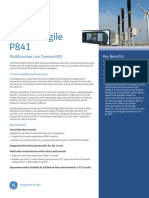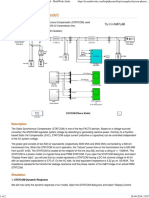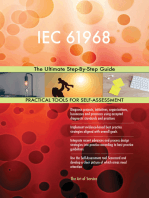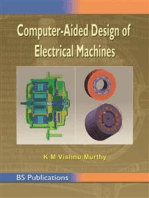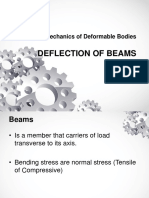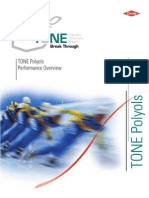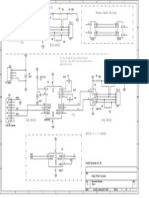STATCOM
STATCOM
Uploaded by
ALPHONCEOriginal Description:
Copyright
Available Formats
Share this document
Did you find this document useful?
Is this content inappropriate?
Report this DocumentCopyright:
Available Formats
STATCOM
STATCOM
Uploaded by
ALPHONCECopyright:
Available Formats
XTICLEEE 1704
XIICLEEE - 12th Portuguese-Spanish Conference on Electrical Engineering
Voltage Flicker Mitigation using a simplified STATCOM model
suitable for long time simulations
Jorge L. Aguero, Fernando Issouribehere
IITREE-LAT, FI, UNLP
Calle 48 y 116, B1900AMF, La Plata, Argentina
j la@iitree-unlp. org. ar
Abstract- Voltage fluctuations caused by fast changes of
industrial loads have been a major concern for both power
companies and customers in the area of power quality. The fast
response of the Static Compensator (STATCOM) makes it an
efficient solution for improving power quality in distribution
systems. This paper describes a simplified model for a PWMbased STATCOM used in a distribution system for mitigation of
voltage fluctuations produced by an Electric Arc Furnace
(EAF).
The
analyzed
system
is
modeled
using
MATLAB/SIMULINK Power System Blockset (PSB), including
a complete STATCOM model with its power circuits and its
control system. Static and dynamic performance of STATCOM
is evaluated and voltage fluctuation mitigation studies are
performed and discussed. The voltage fluctuation mitigation is
obtained by simulations and according to international
standards.
The capability of the STATCOM to mitigate voltage
fluctuations is demonstrated by digital simulations and
experimental results.
II. POWER SYSTEM CONFIGURATION
The one-line diagram of the steelwork power system is
shown in Fig. 1.
I. In t r o d u c t io n
Many loads connected to electric power systems may
cause power quality problems at all voltage levels and for very
different power ratings due to their unbalanced and non
linear behaviour characteristics. However, the main sources of
power quality problems affecting large numbers of customers
are the high power industrial loads. The fast large swings in
active and reactive power required by such loads, cause fast
repetitive voltage variations with appreciable voltage
distortion caused by harmonics and unbalance. The
residential and commercial customers supplied by the same
network are subjected to the impact of these voltage variations
that produce disturbances to their equipment and flicker in
the light output of their electric lamps.
EAF loads can cause serious electrical disturbances on a
power system. Low level amplitude modulation of the supply
voltage of less than 0.5% can cause annoying flicker in lamps
and invoke public complaints when the frequencies lie in the
range of 3-10 Hz.
The most effective way to control voltage fluctuations and
therefore to limit flicker is to compensate the reactive power
variations of the fluctuating loads at medium/high voltage
levels.
This paper presents the voltage flicker measured at a
steelwork busbar, where an 8-ton, 2.5 MW EAF is connected.
To mitigate the voltage fluctuation phenomenon, a 4 MVAr
STATCOM was included in the steelwork busbar.
The mathematical model and the control strategy to
compensate voltage fluctuations are explained and described
in detail hereinafter.
Fig. 1. Steelwork one-line diagram
The steelwork is supplied directly from public distribution
network at 13.2 kV. Measurements of three-phase voltages
and currents were performed at point 1 (steelwork supplying
point) and point 2 (primary of EAF feeding transformer).
III. POWER QUALITY MEASUREMENTS
An EAF consists of a refractory lined shell which holds
the charge, usually scrap metal. Three large electrodes are
held in special clamps on a swing support structure, which
can be swung aside for charging, and which allows each
electrode to be moved according to the output of the control
system.
After the furnace is charged with scrap, operation begins
by lowering the electrodes to strike electric arcs between the
electrodes and the scrap. The heat generated by the three
electric arcs provides the heat for melting the scrap.
There are several phases in the EAF operation, each
presenting a different impact on the power system in terms of
flicker, namely: Boring, Melting and Refining periods. Fig. 2
shows the measured EAF active and reactive power during a
typical furnace heat.
XI1CLEEE - 12th Portugneae-Spanish Conference on Electrical Engineering
XIICLEEE_1704
Total observations of 10 minutes
PatS5%
Observations with Pst > 1
Percent of measurement with P* > 1
1008
2.21
288
28.6%
The obtained value o f Pst9j% = 2.21 is above the lim its o f
European and Argentinian Standards.
B. F licker compensation ratio and STACOM rating
The arc furnace apparent power could be determined
according to the power factor lim it described in [2].
Fig. 2. Active and reactive power measurements during a Furnace Heat.
A. Flicker measurements
Flicker measurements were made by the IITREE-LAT
with the IEC 61000-4-15 normalized flickermeter [1]. Fig 3
shows the results obtained from P,* measurements in 1-minute
interval during a complete furnace cycle. This non
normalized measurement was performed to evaluate flicker
severity caused by fast voltage fluctuations especially during
the first charge o f scrap metal.
It is possible now to estimate the ratio between the EAF
apparent power and the short circuit level at the steelwork
supplying point.
With this K factor, it is possible to obtain the maximum
flicker that could be emitted by the steelwork, according to
Argentinian regulations [21.
According to this value, it is possible to estimate the
flicker compensation ratio:
This parameter is o f fundamental importance for the
determination o f the STATCOM compensator size.
From observations o f practical installations the
approximate equation for estimating the STATCOM rating
for the operation with an EAF is given in [3].
Fig. 3. P,t measurements during a normalized period
The furnace cycle depicted in Fig. 3 was 2 and a h alf hour
long and the furnace was recharged twice after the initial
charge. It is interesting to note that the perturbation level
decays as the metal becomes liquid and the arc becomes
shorter and more stable. Fig 4 shows the normalized oneweek, 10-minute-interval Pat measurements.
IV. STATCOM OPERATING PRINCIPLES
The STATCOM is essentially a voltage source behind a
coupling reactance with the corresponding V-I and V-Q
characteristics [3]-[5] shown in Fig. 5.
Fig. 4. P,t measurement during a normalized period.
The statistical results obtained from the normalized flicker
measurement are presented in Table I.
Table I. Statistical result of Flicker measurement
XIICLEEE_1704
XIICLEEE - 12th Portuguese-Spanish Conference on Electrical Engineering
From Fig. 5, it is possible to conclude that:
The STATCOM can be operated all over its full output
current range even at very low system voltage levels.
In other words, the output current can be maintained
independently from the a.c. system voltage.
distribution system for the voltage fluctuation mitigation
study.
See = 300 MVA
,71
Steelwork feeder
The maximum Var generation or absorption changes
linearly with the a.c. system voltage.
The independence of STATCOM output from
equivalent system impedance means that the voltage
regulator controlling the STATCOM output can be
designed for a faster response rate and can provide
stable regulation over the full range of system
contingencies.
The single line diagram of the STATCOM for reactive
power supply to the transmission system is shown in Fig. 6,
where U is the voltage of the steelwork busbar and Ec is the
controllable output voltage.
Va
VaSteelwork (pu)
[> Operating Mode VdcP
Trip
la_Pcc
Vdc
Q (Mvar)
N
A
B
P (MW)
DV/V (%)
Measurements
Fig. 8. MATLAB model of Utility/Customer system.
The EAF is modeled as three controlled current sources,
governed by the measured currents in the EAF during a
furnace heat. The arc furnace model is shown in Fig. 9.
Controlled C urrent
Source
From
W orkspace
Controlled C urrent
Suource
o
u ru e
From
W orkspace
Controlled C urrent
S ource
From
W orkspace
<2>*~
Fig. 6. STATCOM scheme for reactive power generation.
lb
The active and reactive power exchanged between the
network is given by:
rk-
<!>Ic
Fig. 9. Arc Furnace model.
If the amplitude Ec of the output voltage phasor (Ec) is
increased above the amplitude U of the a.c. voltage (U), then
the current phasor leads the voltage phasor and current flows
from the converter to the a.c. system and the converter
generates reactive (capacitive) power to the system.
If the amplitude of the output voltage phasor is decreased
below that of the a.c. system voltage phasor, then the reactive
current flows from the a.c. system to the converter, and the
converter absorbs reactive (inductive) power from the a.c.
system. This operation is illustrated in Fig. 7.
VI. STATCOM DETAILED MODEL
The 4 MVAr STATCOM SIMULINK detailed model is
shown in Fig. 10. It contains a PWM IGBT inverter, two
10000 jaF capacitors and a control system. The STATCOM is
coupled in parallel with the network through a 0.4/13.2 kV
A-Y transformer [6]-[8].
B <s>c
B i f "
C v
*
b
c
VdcP
-*d>
B
C
- a >
-3>
PWM Controller
Fig. 7. Capacitive and Inductive behaviour of STATCOM.
V. UTILITY/CUSTOMER POWER SYSTEM MODEL
A digital simulation model of the distribution network is
implemented by using the MATLAB/SIMULINK Power
System Blockset (PSB). Fig. 8 shows the upper level of the
Fig. 10. STATCOM block diagram.
A PWM pulse generator of 1.65 kHz is used to control
IGBT bridge. The modulation scheme used is of sinusoidal
XIICLEEE - 12th Portuguese-Spanish. Conference oa Electrical Engineering
XHCIEEE_1704
type. The controller diagram is shown in Fig. 11. It consists
of several subsystems: a phase-locked loop (PLL), a
measurement system, an a.c. voltage regulator, a d.c. voltage
regulator and a current regulator.
The PLL is synchronized to the fimdamental of the
transformer primary voltage to provide the synchronous
reference required by the abc-dqO transformation. The
measurement block computes the d-axis and q-axis
components of the voltages and currents.
The current regulation consists of two PI controllers that
control the d-axis and q-axis currents according to (9)-(10).
The controller outputs are the voltages Ei and
that the
PWM inverter has to generate according to (11)-(12). Then
these voltages are converted into phase voltages EM, ECb and
E c c .
Fig. 11. STATCOM Controller.
The implementation of the control system is based on d-q
compensation theory. The compensator input currents track
the reference currents by means of the following current
controller equations:
The STATCOM model mentioned above is described in
[6] where is presented a detailed model of the inverter that
includes the switching of the inverter power switches. This
model requires a very small computing time step to represent
correctly the PWM waveforms (Tg = 5 (j.s). The simulation
time is thus fairly long and it is not possible to perform
simulations longer than 5 seconds due to memory
requirements.
Vn. STATCOM AVERAGED MODEL
If we are not interested to represent the chopping of the
PWM waveforms, we can use instead a voltage source having
the same averaged value computed upon a chopping period
(Tc = 1/1650) in this case. By using this Averaged Model,
we can simulate the system operation with a larger step time,
resulting in a simulation time reduction or, put in another
way, the total simulation time can be increased up to 60
seconds.
The Averaged Model can be built based on the energy
conservation principle, taking into account that the
instantaneous power must be the same on the AC side and the
DC side of the inverter (neglecting losses). The DC current in
the DC-link capacitor can be then computed from the
measured AC instantaneous power and the DC-link voltage
Udc as:
Fig. 12 shows the SIMULINK implementation of the
inverters Averaged Model. On the AC side, the inverter is
modeled three controlled voltage sources which are
determined by three voltages V^c from the control system. On
the DC side, it is modeled by the DC-link Model. In this
model, a capacitor (represented by an integrator) is charged
by a DC current source with a value computed as shown in
(15). A Switch block is used to avoid a division by zero at
starting when the capacitor has no charge.
XIICLEEE_1704
XIICLEEE - 12th Portuguese-Spanish Conference on Electrical Engineering
Fig. 14. Busbar voltage controlled by both STATCOM models.
IX. TESTING THE STATCOM AVERAGED MODEL
WITH THE EAF MODEL
Fig. 12. SIMULINK diagram of the PWM inverter Averaged Model.
VIII. TESTING THE STATCOM AVERAGED MODEL
WITH A DYNAMIC LOAD
The ability of a compensator to reduce flicker depends on
the compensator size and speed of response. In order to
evaluate the speed of response of both STATCOM models,
the Three-Phase Dynamic Load from SIMULINK was
utilized. The active power was set constant at 2.5 MW, and
the reactive power was set at 1.8 MVAr. This load is
representative of the active and reactive power levels reached
by the arc furnace during a complete heat cycle. As it can be
shown in Fig. 13 a positive step change of 1.2 MVAr is
applied at time t = 0.4 s then a negative step of -3.4 MVAr is
applied at t = 0.7 s, and finally the reactive power recovers its
original value at t = 1 s.
Fig. 14 shows the obtained results for the busbar voltage
where both models of STATCOM were connected.
As a result, both models (detailed and averaged) showed a
similar response.
Digital simulations were performed to evaluate the flicker
mitigation in different phases of operation of the EAF when
both STATCOM models were connected to the steelwork
busbar. The steelwork busbar voltage without STATCOM and
with both STATCOM models is shown in Fig. 15 and Fig.
18. The reactive power supplied by both STATCOM models
is shown in Fig. 16 and Fig. 19. And finally, the DC-link
voltage of both STATCOM models is shown in Fig. 17 and
Fig. 20.
2.5
3.5
4.5
Fig. 15. Steelwork busbar voltage.
S T A T CO M -detailed
STATCO M- ave raged
2.5
3.5
4.5
Tim e [s]
Fig. 16. Reactive power supplied by both STATCOM models.
Fig. 13. Reactive power supplied by both STATCOM models.
Tim e [sj
XIICLEEE - 12th Portuguese-Spanish Conference oa Electrical Engineering
XHCIEEE_1704
environment. The Pst values obtained in the case without
STATCOM in operation were similar to the ones obtained by
field measurements performed in the steelwork. It can be seen
in this figure that the Pst values obtained with both
STATCOM models were practically the same. The averaged
STATCOM models has the important additional advantage of
being able to perform simulations up to 60 seconds long, and
therefore the Flicker values obtained are more representative
of those obtained with the connection of a real STATCOM.
Time
Fig. 21. Pst evaluation during a complete heat cycle.
Fig. 18. Steelwork busbar voltage.
The ability of a compensator to reduce flicker depends
mainly in the speed of response of the control system, and in
both STATCOM models the control loop parameters were
adjusted to be exactly the same. The minor differences in both
responses are due to inefficient filtering of high frequencies
generated by commutation of high power IGBT switches, in
the case of STATCOM detailed model.
Additionally, both STATCOM models reduce Flicker
levels under the requirements of International and
Argentinian Standards.
X. CONCLUSIONS
Fig. 19. Reactive power supplied by both STATCOM models.
Fig. 20. DC-link voltage of both STATCOM models.
As it can be seen in the previous figures, both STATCOM
models presented a very similar response.
Finally, Fig. 21 presents the Flicker level (Pst95%) in the
steelwork busbar voltage, during a complete furnace cycle.
The Flicker level was obtained by digital IEC 61000-4-15
Flickermeter model implemented in MATLAB-SIMULINK
In this paper two STATCOM models for voltage Flicker
compensation has been compared.
The first model, called detailed model was described in
detail by the same authors in [6]. This model has the
important advantage of been a physical model that includes
all the power electronics associated with the PWM converter.
However, this model requires a very small computing time
step (Ts = 5 (is) to adequately represent the PWM waveforms.
With this model can not be achieved simulation times of more
than 5 seconds.
The second model, called averaged model was described
in detail in [7], this model is based on the energy
conservation principle and the PWM inverter is replaced by
three controlled voltage sources and the DC-link is replaced
by a control loop where the capacitor is replaced by an
integrator. In this model the computing time step can be
increased ten times and simulation times of 60 seconds can be
achieved.
Both STATCOM models have demonstrated very similar
performance in compensating Flicker generated by an EAF,
and are valid for Flicker mitigation and propagation studies.
However, the 60 second simulations long are suitable for
XIICLEEE - 12th Portuguese-Spanish Conference on Electrical Engineering
Flicker studies and for comparison with real Flicker
measurements performed every one minute.
XTICLEEE_1704
[5]
[6]
XI. REFERENCES
[1]
[2]
[3]
[4]
IEC 61000-4-15. Electromagnetic Compatibility (EMC). Part 4: Testing
and measurement techniques. Section 15: Flickermeter. Functional and
design specifications.
Anexo a la Resolution ENRE 99/97. Base Metodoldgica para el Control
de la Emision de Perturbaciones. Etapa 2.
Static Synchronous Compensator (STATCOM) for Arc Furnace and
Flicker Compensation. WG B 4 .19. CIGRE Publication. December 2003.
Understanding FACTS: Concepts and Technology of Flexible AC
Transmission Systems. Narain G. Hingorani, Laszlo Gyugyi. Wiley-IEEE
Press 1999. ISBN-0780334558
[7]
[8]
Thyristor-Based FACTS Controllers for Electrical Transmission Systems.
R. Mohan Mathur, Rajiv K. Varma. IEEE Press and Wiley & Sons, Inc.
2002. ISBN 0-471-20643-1.
STATCOM Modeling for Mitigation of Voltage Fluctuations caused by
Electric Arc Furnaces. J. Agiiero, F. Issouribehere and P. Battaiotto. 2006
PES General Meeting. 1-4244-0493-2.
Modeling and Simulation of a Distribution STATCOM using Simulink's
Power System Blockset. P. Giroux, G. Sybille, H. L. Huy. Pp. 990-994.
0-7803-7108-9/01.
Voltage Flicker Mitigation Using PWM-Based Distribution STATCOM.
J. Sun, D. Czarkowski andZ. Zabar. Pp 616-621. 0-7803-7519-X/02.
You might also like
- The Technology of Instrument Transformers: Current and Voltage Measurement and Insulation SystemsFrom EverandThe Technology of Instrument Transformers: Current and Voltage Measurement and Insulation SystemsNo ratings yet
- Nokia Q1 PollerDocument78 pagesNokia Q1 PollerSiddique TL0% (1)
- D1146, P086Document314 pagesD1146, P086griffithNo ratings yet
- PCS6000 STATCOM Ancillary Functions Wind Park Resonance DampingDocument6 pagesPCS6000 STATCOM Ancillary Functions Wind Park Resonance DampingSergio ValentinNo ratings yet
- STATCOM Presentation RMDocument10 pagesSTATCOM Presentation RMkhadijaamir435No ratings yet
- ABB Westermost Reference STATCOMDocument8 pagesABB Westermost Reference STATCOMProyectos IPC S.A.S - Manuel CadenaNo ratings yet
- Dia 2 Colegio de Ingenieros Del Perú - Capacitacíon Tecnica - PQ - R0Document54 pagesDia 2 Colegio de Ingenieros Del Perú - Capacitacíon Tecnica - PQ - R0Easy Energy SACNo ratings yet
- TransfixDocument2 pagesTransfixreza515heiNo ratings yet
- Abbacus: Metal Enclosed Capacitor BankDocument36 pagesAbbacus: Metal Enclosed Capacitor BanksbjamdadeNo ratings yet
- Generator Protection - 7UM85 - Technical DataDocument42 pagesGenerator Protection - 7UM85 - Technical DataDoan Anh TuanNo ratings yet
- Transformer Monitoring Systems - MRDocument4 pagesTransformer Monitoring Systems - MRKelly chatingNo ratings yet
- Final Simple Facts SummaryDocument11 pagesFinal Simple Facts SummaryIhuhwa Marta TauNo ratings yet
- Flexible AC Transmission SystemDocument5 pagesFlexible AC Transmission SystemAliq FazliNo ratings yet
- TM View Software User's ManualDocument73 pagesTM View Software User's Manualrommel76No ratings yet
- Micom Agile P841: Grid SolutionsDocument8 pagesMicom Agile P841: Grid SolutionsTaQuangDucNo ratings yet
- E126Document16 pagesE126José Antonio TenaNo ratings yet
- 4.0 Manual Kelman TransfixDocument31 pages4.0 Manual Kelman Transfixcorreo_hechizo100% (2)
- CSE - 27 A1 An Innovative Power System Stabilization Method With Augmented Inertia Synchronous CondensersDocument13 pagesCSE - 27 A1 An Innovative Power System Stabilization Method With Augmented Inertia Synchronous CondensersPower System OperationNo ratings yet
- Smart GridDocument44 pagesSmart GriddaminhvienNo ratings yet
- GTO Based STATCOMDocument7 pagesGTO Based STATCOMEngr Imtiaz Hussain GilaniNo ratings yet
- ABB 1HDX580101en ELK04Document32 pagesABB 1HDX580101en ELK04gejiro73100% (1)
- Comparison of SVC and STATCOM in Static Voltage STDocument7 pagesComparison of SVC and STATCOM in Static Voltage STAnton MatzNo ratings yet
- Adaptive Protection Scheme For Smart GridsDocument6 pagesAdaptive Protection Scheme For Smart GridsMiguel QuispeNo ratings yet
- Power Quality: More Papers and Presentations Available On Above SiteDocument10 pagesPower Quality: More Papers and Presentations Available On Above SiteBharadwaj SanthoshNo ratings yet
- 1MRB520046 LenDocument218 pages1MRB520046 Leninsan_soft6498No ratings yet
- 16280x Eaton MV Autovar PFC Capacitor Bank Specifications Oct112013Document16 pages16280x Eaton MV Autovar PFC Capacitor Bank Specifications Oct112013Ahmed Said GhonimyNo ratings yet
- ARTIGO - Kersting 2010 - Distribution Feeder Voltage Regulation ControlDocument7 pagesARTIGO - Kersting 2010 - Distribution Feeder Voltage Regulation ControlAndrey LopesNo ratings yet
- PMU SpecificationDocument13 pagesPMU Specificationabhi120783No ratings yet
- NDPLDocument27 pagesNDPLkaushal895No ratings yet
- A STATCOM-Control Scheme For Grid Connected Wind Energy System For Power Quality ImprovementDocument15 pagesA STATCOM-Control Scheme For Grid Connected Wind Energy System For Power Quality Improvementk rajendraNo ratings yet
- TranswinDocument3 pagesTranswinPatel Ashok100% (1)
- ABB 1HDX580100en ELK04Document4 pagesABB 1HDX580100en ELK04vicesuza87No ratings yet
- Stat ComDocument13 pagesStat ComSanthi Manoj VaddiNo ratings yet
- The Transfer Function Method For Detection of Winding Displacements On Power TransformersDocument14 pagesThe Transfer Function Method For Detection of Winding Displacements On Power TransformersShravan BhattNo ratings yet
- ATP Petersen Coil PracticalExerciseDocument33 pagesATP Petersen Coil PracticalExerciseGesiel SoaresNo ratings yet
- 02-1 Synchronous MachinesDocument48 pages02-1 Synchronous MachinesvenikiranNo ratings yet
- A FACTS Device Distributed PowerFlow Controller (DPFC)Document8 pagesA FACTS Device Distributed PowerFlow Controller (DPFC)narashimamurthyNo ratings yet
- Power Systems Consulting: Efficient Grids For Electric Utilities and Industrial CompaniesDocument41 pagesPower Systems Consulting: Efficient Grids For Electric Utilities and Industrial Companiespmandwani4687No ratings yet
- Space VectorDocument5 pagesSpace VectorSatya Kumar NgvNo ratings yet
- Fault Current Contribution From VSC-based WindTurbines To The GridDocument8 pagesFault Current Contribution From VSC-based WindTurbines To The GridhassanNo ratings yet
- RM6 ManualDocument56 pagesRM6 ManualMuhammed DemirNo ratings yet
- SVC Abb Case StudyDocument2 pagesSVC Abb Case StudybhsujanNo ratings yet
- Harmonic Filtering - Electrical Installation GuideDocument4 pagesHarmonic Filtering - Electrical Installation GuidedhruvNo ratings yet
- STATCOM (Phasor Model) - MATLAB & SimulinkDocument2 pagesSTATCOM (Phasor Model) - MATLAB & SimulinkAnonymous i8hifn7No ratings yet
- Specification NGRDocument7 pagesSpecification NGRPrasenjit MaityNo ratings yet
- FOLD presentation-WAMSDocument41 pagesFOLD presentation-WAMShemanth727No ratings yet
- Protecciones de Tierra de TransformadoresDocument9 pagesProtecciones de Tierra de Transformadoresmaidenheavy1No ratings yet
- Hybrid STATCOM Project Nalagarh: A Tour ToDocument37 pagesHybrid STATCOM Project Nalagarh: A Tour ToRohit SharmaNo ratings yet
- Calculation and Analysis of Transformer Inrush Current Based On Parameters of Transformer and Operating ConditionsDocument4 pagesCalculation and Analysis of Transformer Inrush Current Based On Parameters of Transformer and Operating ConditionshnphuocNo ratings yet
- Load Tap Changing Control - BeckwithDocument9 pagesLoad Tap Changing Control - BeckwithTarcisio Flávio100% (1)
- Artificial Loading of Induction MotorsDocument6 pagesArtificial Loading of Induction Motorsamkeew100% (1)
- High Burden Tripping Relay RXMN & RXMVC41Document12 pagesHigh Burden Tripping Relay RXMN & RXMVC41vishnusinghal2007No ratings yet
- CTreq forGErelays R6.9bookDocument97 pagesCTreq forGErelays R6.9bookVíctor Casado100% (1)
- Doubly-Fed Induction Machine Models For Stability Assessment of Wind FarmsDocument6 pagesDoubly-Fed Induction Machine Models For Stability Assessment of Wind FarmsArun RajendranNo ratings yet
- Three Phase Power System in MathcadDocument11 pagesThree Phase Power System in MathcadkamuikNo ratings yet
- STATCOM and Capacitor Banks in A Fixed-Speed Wind PDFDocument12 pagesSTATCOM and Capacitor Banks in A Fixed-Speed Wind PDFيوسف خضر النسورNo ratings yet
- ABB Wind Turbine Converters: PCS6000, Full Power Converter, Up To 12 MWDocument12 pagesABB Wind Turbine Converters: PCS6000, Full Power Converter, Up To 12 MWgjghhdgNo ratings yet
- Business Model PARAMAWE Solar Energy LTDDocument5 pagesBusiness Model PARAMAWE Solar Energy LTDALPHONCENo ratings yet
- Convivium Solar ProjectDocument1 pageConvivium Solar ProjectALPHONCENo ratings yet
- Lilondi AgreementDocument1 pageLilondi AgreementALPHONCENo ratings yet
- Legal Opinion On Hareket PowerDocument2 pagesLegal Opinion On Hareket PowerALPHONCENo ratings yet
- Letter To Mwenga On Encroaching Distribution NetworkDocument2 pagesLetter To Mwenga On Encroaching Distribution NetworkALPHONCENo ratings yet
- Proposed Cost Estimate For Pipes and Fittings To Be Used For Extension of Water Supply Network at BugayambeleleDocument1 pageProposed Cost Estimate For Pipes and Fittings To Be Used For Extension of Water Supply Network at BugayambeleleALPHONCENo ratings yet
- Proposed Cost Estimate For Pipes and Fittings To Be Used For Water Extension Busongo (Distribution)Document1 pageProposed Cost Estimate For Pipes and Fittings To Be Used For Water Extension Busongo (Distribution)ALPHONCENo ratings yet
- Osha Construction PDFDocument65 pagesOsha Construction PDFAlex Xocoxic PeinadoNo ratings yet
- Lesson Plan 6 Electrical Installation and Maintenance I. ObjectivesDocument6 pagesLesson Plan 6 Electrical Installation and Maintenance I. Objectivescecille mañacapNo ratings yet
- Proposed Solar PV Plant Labour Colony Area: Engineers & Consultants (FZC.,) Sharjah, UAEDocument1 pageProposed Solar PV Plant Labour Colony Area: Engineers & Consultants (FZC.,) Sharjah, UAEMuhammad NasarNo ratings yet
- Deflection of Beam - 2sDocument19 pagesDeflection of Beam - 2sDave Harrison FloresNo ratings yet
- Appliance Star RatingsDocument15 pagesAppliance Star RatingsJoss DoeNo ratings yet
- Padestral FanDocument4 pagesPadestral Fanmehul vyasNo ratings yet
- Uniform Standardfor Wood Containers 2009Document44 pagesUniform Standardfor Wood Containers 2009McArthur2010No ratings yet
- Cbse Python Language BasicsDocument11 pagesCbse Python Language BasicsVr MageshNo ratings yet
- Arduino DUE - DAC Analog OutputDocument3 pagesArduino DUE - DAC Analog Outputmanuel99a2kNo ratings yet
- Gauge Weight CalculationDocument12 pagesGauge Weight CalculationNadira PervinNo ratings yet
- A320m-K Pro V14Document12 pagesA320m-K Pro V14Justin PhilipNo ratings yet
- Inv 1200Document2 pagesInv 1200Al De LeonNo ratings yet
- Esp Fault FixDocument3 pagesEsp Fault FixElisabete MoraisNo ratings yet
- Need For Speed Underground Setup LogDocument53 pagesNeed For Speed Underground Setup LogPrashant KhandelwalNo ratings yet
- 06 MDB PDFDocument36 pages06 MDB PDFHarry SharmaNo ratings yet
- Instructions For Use: J-Lite JLA-8.1000 and JLA-9.1000 Fixed-Angle Rotor AssembliesDocument52 pagesInstructions For Use: J-Lite JLA-8.1000 and JLA-9.1000 Fixed-Angle Rotor Assembliesfonivaw617No ratings yet
- Bts Reparenting v15Document73 pagesBts Reparenting v15Paul RiosNo ratings yet
- MOW323 Exam 2020aDocument11 pagesMOW323 Exam 2020aNicholas RuestNo ratings yet
- Jyoti Singh Tomar (12/AR/005) - Shashank Bhatt (12/AR/007) - Shah Zain (12/AR/008) - Jai Vardhan Singh (12/AR/011) - Komal Rathore (12/AR/014)Document85 pagesJyoti Singh Tomar (12/AR/005) - Shashank Bhatt (12/AR/007) - Shah Zain (12/AR/008) - Jai Vardhan Singh (12/AR/011) - Komal Rathore (12/AR/014)poojaNo ratings yet
- Grade 8 Math Exam Papers and MemosDocument3 pagesGrade 8 Math Exam Papers and MemosEvelynNo ratings yet
- Tecnam P2002 Sierra Manuale PDFDocument69 pagesTecnam P2002 Sierra Manuale PDFJuanaleNo ratings yet
- SSM Profile 2018Document9 pagesSSM Profile 2018ooty.pradeepNo ratings yet
- AOR To SORDocument24 pagesAOR To SORImtiaz HaqueNo ratings yet
- Primavera - Lecture No. 1 PDFDocument26 pagesPrimavera - Lecture No. 1 PDFInaam Ullah MughalNo ratings yet
- 321 00062 PDFDocument0 pages321 00062 PDFA MahmoodNo ratings yet
- Map Making With QGIS - Part IDocument2 pagesMap Making With QGIS - Part ISagar ArlekarNo ratings yet
- LM2005 Amplificator BassDocument8 pagesLM2005 Amplificator BassAlex MartonNo ratings yet
- Rs 422Document1 pageRs 422rezakaihaniNo ratings yet
















